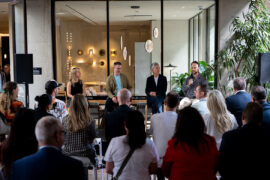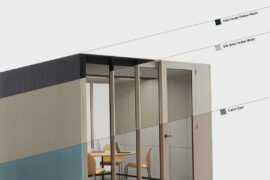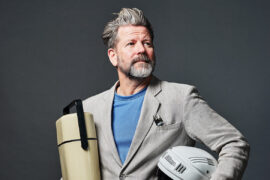The desire to be an agile designer is strong in today’s busy design community, but what does this mean exactly?
June 26th, 2018
While the original Agile Manifesto was published with the agile designer of software in mind, this doesn’t negate its usefulness for those of us in the traditional design and architecture communities. Emphasising people and interactions over processes and tools, agile design is something all of us in the design world can appreciate and channel in our work.
The agile designer is more than just a good designer – they’re the designer of the future. As workspaces, schools and other public areas continue to evolve into more blended areas of activity, it’s the design community’s responsibility to design in response to this. With this in mind, here are Indesign’s top five tips to think like an agile designer…
In designing a future workplace, it’s important to note that the ‘one-size fits all’ approach of the past is best left there. The present day spectrum of agile design and the variety of work-settings available to employees impacts the choice of how and where contemporary workers choose to work. This new paradigm of choice can be chartered through organisational changes, but design too needs to respond to this.
“Trends toward wellness and user experience are critical to maximise engagement,” says Vice President of Haworth International, Glen Foster, “This is the new horizon of performance optimisation and employee retention. Integrating food and beverage strategies and providing social spaces, have become key elements to successful workplace design.”
Ultimately, choice is the modern mantra for employees, with one of the agile designer’s primary responsibilities being to enable employees to choose how to do their best work.

Illustration by Stephen Cheetham for Haworth white paper: ‘Active Ergonomics For The Emerging Workplace’
Part of embracing the agile designer way of thinking is being open to always reviewing your design plans, and renewing your commitment to your goals. Agile training specialist CPrime describes agile design as “a disciplined project management process that encourages frequent inspection and adaptation, a leadership philosophy that encourages teamwork, self-organisation and accountability.”
For PTID and its agile design of Tabcorp’s Melbourne office, the design team adopted numerous aspects of the Agile methodology in developing the concept. Given two weeks to prepare, the team took time out every two to three days to review their progress, reject unsuccessful elements and identify the minimum viable product to take forward into the next stage of the design.
Karen Fairfax, designer and senior associate of PTID said: “The brief from the client was articulated in very clear operational terms, which gave us liberty to develop a powerful occupant experience around a highly effective workplace. The concept was presented in an evolutionary context from initial sketches to planning elements, a fully resolved floor plan followed by an animated 3D fly-through of the entire fitout. It was a compelling presentation with a strong narrative thread that leant robustness to the concept.”




Rapidly evolving technology – from automation to artificial intelligence – means the jobs of tomorrow will be very different from the jobs around today. Tomorrow’s agile thinkers need a range of settings, teeming with technology, which designers need to accommodate for. Think spaces designed for direct instruction that can accommodate collaborative zones for group work. Think rooms for quiet reflection that morph into places for debate and dissection. And think ‘maker spaces’ where ideas can be explored and prototyped. These are the sorts of physical environments that respond to new education and office trends.
According to dwp’s David Clarke, the challenge for architects and designers is not so much a creative one, as a cultural one. “In many cases, interactive, technology-enabled spaces don’t live up to their potential because teachers aren’t able to step away from behind the blackboard and interact with the students in new ways.” Keeping this in mind is essential for the agile designer – who must anticipate the way a space will be used in order to best plan its design.




As much as many contemporary workplaces can be designed as mobile or activity-based to accommodate today’s changing workforce, this is only so useful if the workers themselves have no motivation to move around a space. The frustration of a well-designed space not being used to its full advantage is something agile design can solve. Take Geyer’s design of Suncorp’s new Sydney headquarters, which sees employees taking advantage of the various iterations of workspace across the building levels thanks to Geyer’s smart, agile design. Split over four key floors, the space has two ‘community floors’ on levels seven and 15 that can be used for larger gatherings or as an alternative to off-site meetings, and two different layouts of ‘typical’ work floors sandwiched in-between!




Whenever an architecture studio has the opportunity to play both client and designer, the duality often leads to a more intimate understanding of change management, and a chance to really stretch the wings of the agile designer. Gray Puksand’s total refurbishment of its 12-year-old Melbourne office was such an opportunity for its design team. Working with Schiavello on the agility strategy for the rejuvenated Melbourne headquarters, the collaboration comprised a bespoke solution for the studio, ancillary spaces and overall workplace strategy – even all the way down to the exact specifications that were required – to bring a truly holistic approach to achieving those agile critical success factors.
In order to remain authentic to the company’s design method, the team endeavoured to follow the same process applied to all of its workplace projects, running a series of staff workshops to air out new concepts. These agile processes led to a design that is relaxed, open, and egalitarian. As you enter through the elevator, there is no front desk, and no sense of administrative gatekeeping – rather, guests are encouraged to introduce themselves directly to staff stationed at the first of two main work pods. These undulating stations neatly accommodate informal group interaction, while a number of sit-to-stand desks provide a more engaged work set-up for individuals.




–
For more stories like this, sign up for our newsletter.
INDESIGN is on instagram
Follow @indesignlive
A searchable and comprehensive guide for specifying leading products and their suppliers
Keep up to date with the latest and greatest from our industry BFF's!

Welcomed to the Australian design scene in 2024, Kokuyo is set to redefine collaboration, bringing its unique blend of colour and function to individuals and corporations, designed to be used Any Way!

The undeniable thread connecting Herman Miller and Knoll’s design legacies across the decades now finds its profound physical embodiment at MillerKnoll’s new Design Yard Archives.

The CBD and South Melbourne Precinct promises a day of design experiences that balance movement, wellbeing, innovation and hospitality.

A new online space offers designers enhanced tools, resources and real-time customisation.
The internet never sleeps! Here's the stuff you might have missed

Designed by Kelly Ross, the newest addition to Bisa Hospitality’s portfolio represents more than just another restaurant opening.

‘What a Ripper!’ by comedian and architecture advocate Tim Ross explores Australia’s rich legacy of local product design.

Hospitality is evolving fast, demanding interiors that can flex as quickly as guest expectations. From modular seating to stackable silhouettes, Bowermans brings global design brands and local know-how to help designers shape spaces that perform as well as they inspire.